

Buckwalter Arabic Transliteration. I developed my transliteration system before XML days.
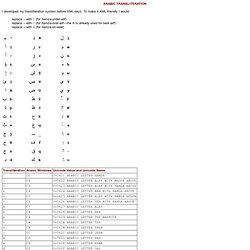
To make it XML-friendly I would: replace < with I (for hamza-under-alif) replace > with O (for hamza-over-alif—the A is already used for bare alif) replace & with W (for hamza-on-waw) The full Arabic character set can be viewed at the Unicode website: Arabic: U+0600 to U+06FF (PDF format) Arabic Presentation Forms-A: U+FB50 to U+FDFF (PDF format) Arabic Presentation Forms-B: U+FE70 to U+FEFF (PDF format) The TITUS page for U+0600 through U+06FF displays the actual characters in your browser (UTF-8 encoding).
You can test your web browser's Arabic Unicode support at Alan Wood’s Unicode Resources website. The Microsoft developer website has a useful table of the Arabic Windows (1256) and ISO 8859-6 code pages and their corresponding Unicode values. Copyright © 2002 QAMUS LLC. Maren Transliteration. Arabic Word Study Tool. Arabic alphabet, pronunciation and language. The Arabic script evolved from the Nabataean Aramaic script.
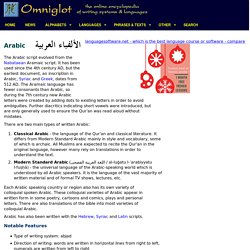
It has been used since the 4th century AD, but the earliest document, an inscription in Arabic, Syriac and Greek, dates from 512 AD. The Aramaic language has fewer consonants than Arabic, so during the 7th century new Arabic letters were created by adding dots to existing letters in order to avoid ambiguities. Further diacritics indicating short vowels were introduced, but are only generally used to ensure the Qur'an was read aloud without mistakes.
There are two main types of written Arabic: Classical Arabic - the language of the Qur'an and classical literature. Each Arabic speaking country or region also has its own variety of colloquial spoken Arabic. Arabic has also been written with the Hebrew, Syriac and Latin scripts. Notable Features Arabic script Arabic consonants The transliteration of consonants used above is the ISO version of 1984. This chart shows how the letters change in different positions. Buckwalter - Arabic Morphology Analysis. Background The Perl skills I developed for corpus compilation, lexical statistics and concordancing eventually allowed me to write my own morphological parser.
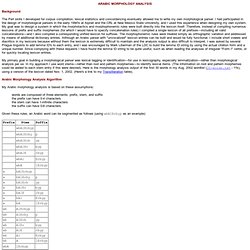
I had participated in the design of morphological parsers in the early 1990's at Alpnet and the CRL at New Mexico State University, and I used this experience when designing my own system. My goal was to design a system in which the morphotactics and morphophonemic rules were built directly into the lexicon itself. Therefore, instead of compiling numerous lexicons of prefix and suffix morphemes (for which I would have to specify concatenation rules) I compiled a single lexicon of all prefixes—including all valid concatenations—and I also compiled a corresponding unified lexicon for suffixes. The morphophonemic rules were treated simply as orthographic variation and addressed by means of additional dictionary entries. Arabic Morphology Analysis Algorithm My Arabic morphology analysis is based on these assumptions: Example: 1. 2. 1. Clavier arabe en ligne LEXILOGOS. Arabe العربية alphabet dictionnaire arabe <font color="red">Attention !
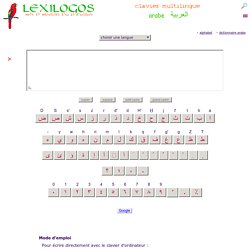
JavaScript n'est pas activé. </font><br> Vous devez activer JavaScript dans votre navigateur pour pouvoir utiliser Lexilogos : veuillez suivre les <a class="ext" href=" target="_blank">instructions</a>. <p> Google Mode d'emploi Pour écrire directement avec le clavier d'ordinateur : Pour les lettres emphatiques, écrire en majuscule exemple : H, S, D, T, Z Pour les lettres accompagnées d'un diacritique, ajouter une apostrophe exemple : t', H', d', s', S', T', g' Caractères spéciaux : Les lettres correspondant aux sons g, p, v n'existent pas en arabe. Notes : Les caractères arabes n'ont pas toujours la même forme lorsqu'ils sont placés au début, au milieu ou à la fin d'un mot. Clavier Arabe Intelligent Yamli™ Le Clavier Arabe Intelligent de Yamli te permet de taper en Arabe en utilisant des caractères latins d'une facon phonétique.
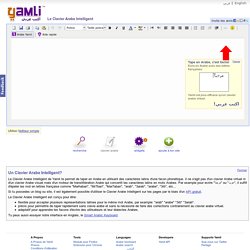
Il ne s'agit pas d'un clavier Arabe virtuel ni d'un clavier Arabe visuel mais d'un moteur de translittération Arabe qui convertit les caractères latins en mots Arabes. Par example pour ecrire "مرحباً" ou "عرب", il suffit d'épeler les mot en lettres française comme "Marhaban", "Mr7ban", "Mar7aban", "arab", "3arab", "arabe", "3rb", etc...
Si tu possedes un blog ou site, il est également possible d'utiliser le Clavier Arabe Intelligent sur tes pages par le biais d'un API gratuit. Le Clavier Arabe Intelligent est conçu pour être: Tu peux aussi essayer notre interface en Anglais, le Smart Arabic Keyboard. Tapez comme vous parlez. Vous pouvez aussi utiliser ces raccourcis rapides. Tapez un tiret ("-") pour grouper les mots. Kal-aghani → كالأغاني Pour plus de conseils sur le clavier arabe, essayez notre aide complète.